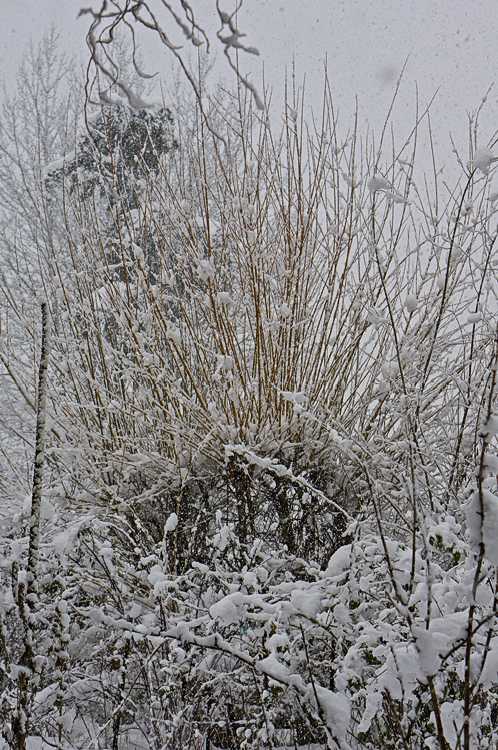Winter Snow Day in Sunny Sequim
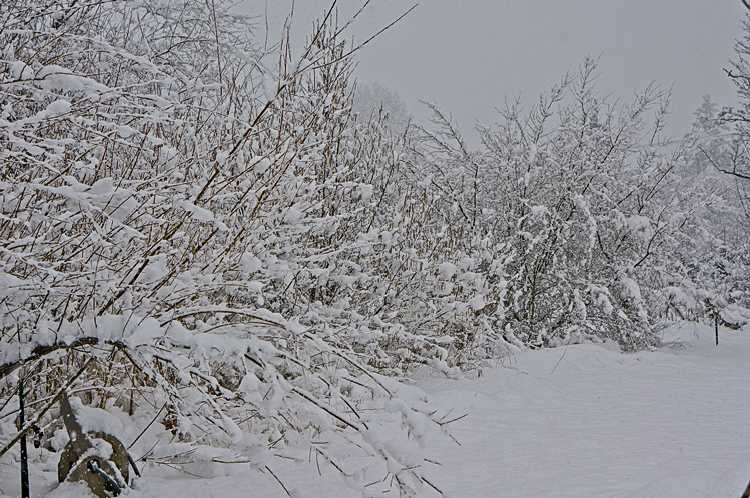
It started in the night. This deep white blanket brought our community to a standstill for a good 10 days (even more in the hills). I have not seen such a snow since 1995, when the heavy stuff brought down our century-old barn, although old timers around here might remember more extreme events. It is but mid-February. We most certainly could get more. I enjoy watching and feeding the birds, and this winter snow event made me reassess how they might survive.
The winter to this point has been so mild, many trees and shrubs were thinking of blooming. And then the storms moved in from the north, accompanied by low temps.
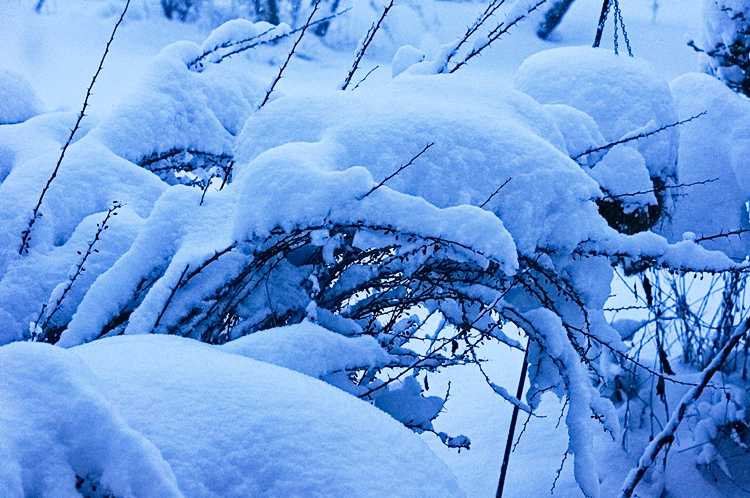
We don’t get snow often, but when we do, it is wet and heavy. Long evergreen branches bend to the ground and some break under the weight. Beneath the low mounds that border my path to the greenhouse are the willows, unrecognizable except I know they are under there. They will spring back; other plants, though, perhaps not. When the wind picks up, the trees came alive, shaking loose their grand arms to free themselves from the heavy loads. The clumps of snow fall from the branches in great clouds of ice crystals that float on the wind and eventually land somewhere soft and quiet. The trees almost seem to dance with the freedom.
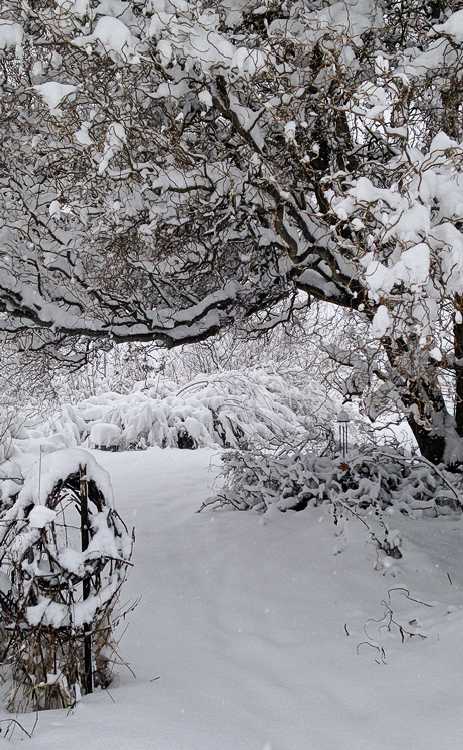
We have not seen the end of this wind or the winter it rides upon.

The deciduous trees seem the most vulnerable, with great clumps frozen to their bare limbs. Little birds flit among the branches. Who are these tiny creatures that dare to face the harshness of winter, with teeny legs no bigger than a darning needle – how do they not freeze? They perch on high to observe what is next; they disappear into the cover of shrubs to wait it through the night.
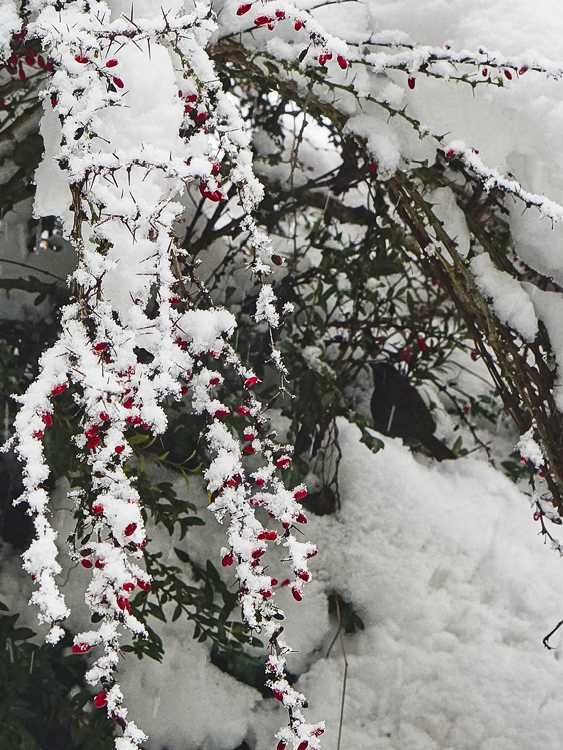
How can these creatures survive?
I am convinced, there is no one thing. The birds do everything they can – a multitude of things – to survive. A harsh twist in the weather can take them right out. The sparrows, finches, and juncos often come and go in groups; one survival trick is in keeping together, not only to tell each other where they find food, but also to keep warm. Others know to stash food (I’ve read this is common with the Steller’s jay and even with the nuthatch). Obtaining enough fuel to make it through the night is a daily struggle.
What we do to help with accessing the big three: food, water, and shelter, can make the difference between life and death.
Food Under Snow
Food in the wild becomes scarce right at the time they need the calories most – and although I try to plant a lot of things for birds and let things go to seed throughout the gardens, during extreme events like these, I question whether it is enough. Birds, of course, will eat whatever they can find, but given a choice, they know to go for the high-protein, high-fat sources. Diets will shift with the seasons.
All puffed out in the winter cold, the little birds, such as the juncos, chickadees, and pine siskins, are first to arrive at the feeders in the morning. The air is so quiet, you can hear the scratching of their tiny feet.

It is amazing how many species will pay us a visit: the numerous finches, some splashed with red, others with yellow, the striped sparrows, some with golden crowns, the dark-hooded juncos, and then the larger birds, the towhees, thrushes, and more recently, families of robins. All seem to eat together with very little infighting or displays of domination. The nuthatches and chickadees are still finding things in the crevices of tree bark.
A Little Something for Everyone….
Sometimes I smear peanut butter on the trunks. I put out seed mixes in the feeders that contain lots of high-fat sunflowers and less of the cheap milo seed fillers. Blocks of suet hang in cages, which are frequented by the downy woodpeckers, chickadees, and bushtits. Chick scratch (the smaller kind) is tossed on the ground for the quail and friends, along with cut-up apples from our orchard for robins, towhees, and other fruit lovers. I also put out peanuts for the Stellar’s jays, who always seem to arrive with such raucous announcements, and the occasional squirrel.
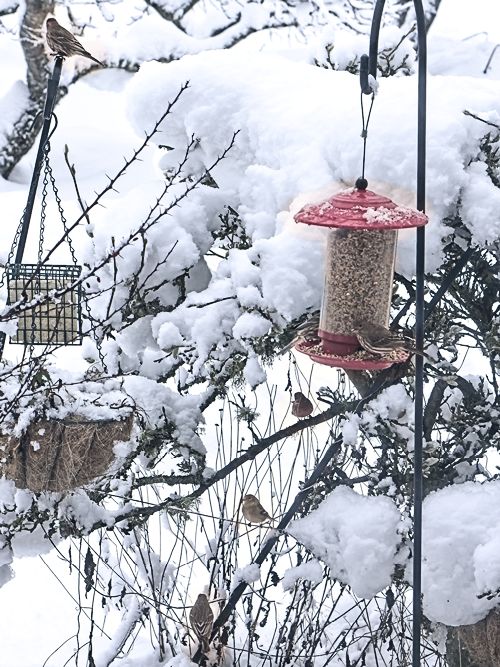
Although very entertaining to watch, these guys were starting to eat us out of house and home! Plus, with all that snow falling, I kept going out there, sweeping aside what I could, and piling more seed on top. Finally, in the midst of a particularly hard snowfall (“Will this ever stop???”), I positioned a couple of pieces of scrap plywood against some sticks for a makeshift lean-to. It worked better than it looked. Some birds seemed to appreciate the extra perch; others liked the privacy screen and wind shelter it provided. (Note to self: build something a little more sturdy for next year.)
Water
Perhaps even more important than food when the temps drop below freezing: a pan of warm water. Whenever I replenish it, within a few minutes, the birds are taking turns from its rim. I have not noticed them splashing in it to bathe in this cold weather. The pan is a plant tray and quite shallow.
Shelter
Shelter can be two things: 1) something that provides safety where they are quite vulnerable when they feed, and 2) where they spend the night.
Safety While Feeding…
One of my feeders appears too much in the open. It hangs from a pole next to a small star magnolia tree. The birds like to hide in the branches and come out for the seed. Others prefer to catch what falls on the ground. However, the skittish quail, their top knots quivering as they eat, never seem totally comfortable here. They always have one eye scoping out the surroundings. They have lingered longer to scratch about in the shelter of my flimsy plywood lean-tos.
A small shrubby hedgerow around the tree would be much better. It would provide shelter, a windbreak, and a real place to hide. Perhaps slow-growing wild huckleberry would work here? There is not a lot of room for anything large or that couldn’t handle pruning. A wattle fence might provide a security screen in the interim.
The primary feeder hangs from a very large fir tree, which provides a natural shelter. A fence borders the property on the far side of it and provides a convenient place for birds to socialize while they wait their turn. On the ground, I often curse the rampant periwinkle, but it has more than once provided a quick escape when a hawk swoops in for a quick bite. Under the snow, however, the periwinkle completely disappeared. Realizing how barren and open it felt there without it, I pulled it up and shook off the snow. Perhaps I will let it grow there after all.
Safety in the Night…
For housing, some people build winter bird houses, and after this winter, I think it is something I’d like to try. For now, though, all our available shelters are whatever the birds can find in the natural landscape. I grow a lot of shrubs, and the big evergreen bay leaf tree (Laurus nobilis) by the barn, with its large overreaching branches and dark caverns beneath, is a popular place.
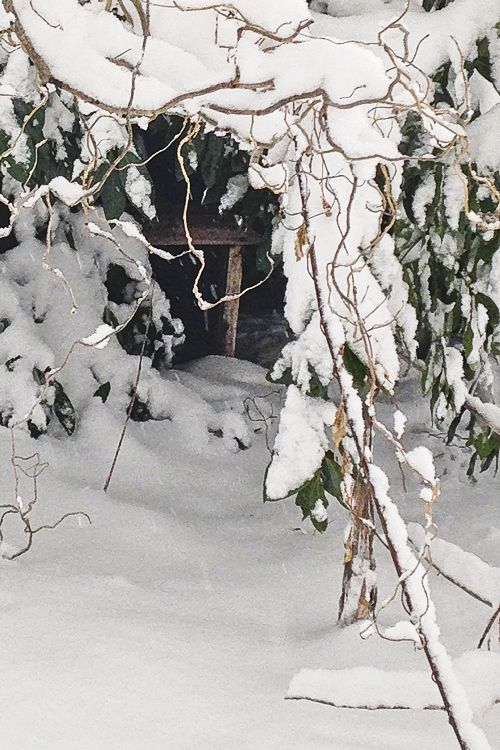
Looking about, I wondered: What other kinds of shelter might wintering animals find here?
In the tall evergreens at the property edges, most certainly, birds can take cover. We are fortunate to have a huge hollowed-out tree at one corner of the property. Scorched from a fire long ago, the tree now houses a multitude of creatures. A tall fir grows to one side; an elder shrub on the other. It is a perfect hideout.
Shrubs can be pruned to be quite dense and provide excellent housing. For example, we have a very large flowering quince that threatens to take over where I like to park my car. Every year, we whack it back, which always seems a bit drastic. Every year, it gets more and more dense in response. It is now an impenetrable thorny thicket. A huge number of birds rest in this shrub at night, and perhaps their combined bodies are able to increase the warmth just a bit. In the morning, this shrub is alive with excited chitters and chatters. In the spring, it literally comes alive with song!
Native and naturalized plants are an easy low-maintenance way to increase habitat and shelter. I’ve noticed the wild rose, Rosa rugosa, grows so dense, it provides excellent cover for small creatures, as well as a source of food. I know the quail and raccoons live in the Himalayan blackberries that have taken over the hillside on the far west side of the property. Other shrubby natives we have growing include red flowering currants, Oregon grape/Mahonia, salal, native huckleberries, and Saskatoons/serviceberries (Amelanchier spp.).
Brush piles are also excellent housing. I stacked orchard prunings in a long pile with the intent of building a Hugelkultur bed of sorts made with branches instead of logs. I never have enough soil to fill in all the gaps, but I keep piling on weeds and other organic matter. Beneath is a nice haven for birds, rodents, insects, and snakes. In other areas, I leave broken limbs from the fir trees on the ground, along with piles of leaves, grasses, and other debris. These are great places for wintering insects, an important food source for the birds.
And then there is the insect hotel that was quite creative and fancy when we first built it but has fallen over repeatedly in our winds, and the last time, I just left it. It is built from an old upcycled bookshelf in which we stacked hollow bamboo, pine cones, rocks, sticks, and whatever else provided a place to hide. I stuffed some dog hair in there, which I noticed birds were freely taking. With it tipped over, it perhaps provides an even better shelter for spiders and assorted bugs. I will set it back up in the spring in a better location.
Planning Gardens for the Birds
This down time is a good time to plan our gardens for the birds. If we create a place where insects can flourish, the birds will surely come. Once winter arrives, however, those brave souls that decide to stay will also need shelter. Some will seek trees and shrubs; others hunker down in brush piles; some will survive in numbers by staying close to one another, but still in the shelter of something.
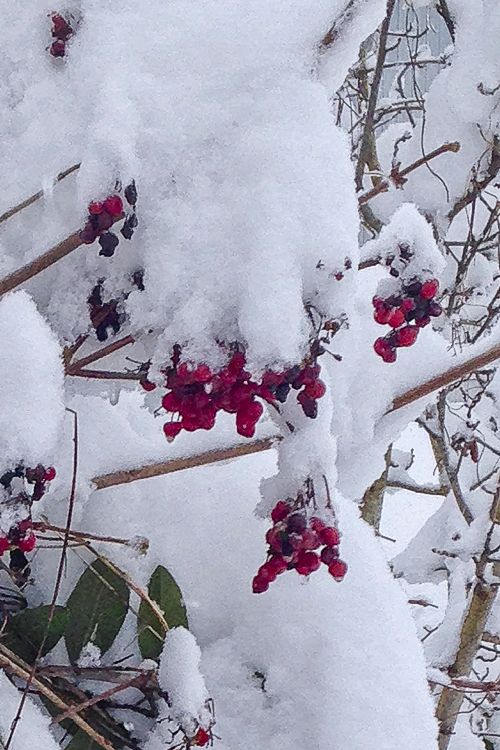
What will they eat? American Highbush Cranberry keeps its berries all through the winter, as do rosehips and berberis. Snowberries (Symphoricarpos albus) are often stated as a food source, but my guess is the saponins in them make them more of a last-resort food. Viburnums and the strawberry trees (Arbutus unedo) are interesting in that they seem to flower and fruit at the same time during most of the year. The hazels open their catkins in mid-winter, which is nice for the bees, and the willows are not far behind, depending on the variety. Audubon makes a good case for planting natives appropriate to your area: the birds recognize them and therefore spend less time and energy foraging.
Not all of us can grow a field of grain, but we can grow small patches of seed-bearing flowers and grains that can still supply quite a bit of seed. The Chenopodium species, in particular, produce an abundance of seed: amaranth and quinoa, for example. I grow something called purple goosefoot (Chenopodium giganteum), aka “tree spinach,” a beautiful tall growing spinach like plant with magenta velvety leaves. Another Chenopodium I grow is the perennial vegetable, Good King Henry, which also produces quite a few seeds. This year, I’m going to try my hand at flax. I would like to try niger, chia, and sunflowers that produce the black oil seeds (Peredovik) rather than the striped snacking variety I usually grow. Quinoa and amaranth have both done well for me, and I might try to make room for them again this year.
Wild and bronze fennels and sweet cicely, although potentially invasive, provide not only a lot of seed, but also umbel flowers in the spring that support beneficial wasps, and tubular stems that provide hiding places for spiders and insects (which may also be a food source). A wide variety of flower seeds are bird favorites: asters, beebalm, coreopsis, goldenrod, Joe Pye (Eutrochium), poppies, rudbeckia, and sedums, in addition to the obvious sunflowers — too many to list here. Many are quite sturdy and may still contain seeds come winter or can be collected for later use.
But what about seeds that might be found out in the field? Grasses are pretty well flattened at this point. The dark tall spires of curly dock are easy to find and a good “weed” to allow to grow (it has medicinal value and we can make flour from the seeds). I suppose thistles might also be good, but I am not advocating growing thistles—teasel might be an exception. Perhaps the easiest thing to do is to take a walk at this time of year and see what you find — and then perhaps dedicate a wild meadow area to allow some of these plants to take a foothold.
The Big Thaw
As the snow melts, the bird voices rise with the sun, and are soon so loud, the air is filled with their excited chirps and twitters: “We will get through this! Spring will still return!”
I survey the snow damage: major broken branches in the Dunbar plum, autumn olive, one of the strawberry trees, and in the large rosemary shrubs…. The damage is severe, but minimal.
The wild blackberries that border the property were nearly flattened with the snow. Beneath them live a covey of quail. I frequently count 12 at the feeders, but during the storm, none. I worried for this family. Could they get out? Could they survive? They must feel so exposed if they venture out on the open snowfield.
And then one day I was sitting in my chair with my morning coffee – things were starting to drip everywhere – and I looked up to see a fat little top-knotted bird hopping across the snow. Soon a group of them were gobbling up the mound of seed that had accumulated from my repeated attempts to keep food available during the snowstorms. If all goes well, we can expect a healthy clutch of young in the spring. This thought makes me smile.
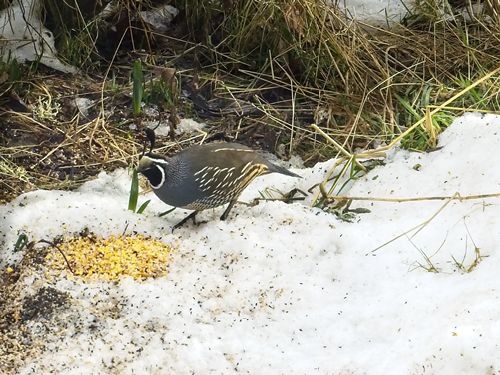

I would like to hear from my readers – what are you growing for the birds? Do you grow and mix your own birdseed? Where do the birds find shelter in the harshest times of winter – and do you do anything extra to help them through this time?
Thank you!
From our oasis to yours,
Blythe
P.S. I have lots of the purple goosefoot and Good King Henry seed, if anyone is interested. You can contact me here.
Looking for Seed to Grow Your Own Seed?
Here is a list of some of my favorite seed companies and plant nurseries that carry grains and bird-friendly plants:
- Baker Creek Heirloom Seeds
- J.L. Hudson, Seedsman
- Oikos Tree Crops
- Peace Seedlings
- Pinetree Seedsh
- Plant Native (nursery finder, plant lists, how-to)
- Prairie Garden Seeds (Canadian friends; yes, they do ship to the U.S.)
- Prairie Moon Nursery
- Quail Seeds (new friends from Bountiful Gardens. Check them out!)
- Seeds of Change
- Siskiyou Seeds
- Uprising Seeds
- West Coast Seeds
Further Reading and Resources:
- Audubon: “Turn Your Yard into a Winter Refueling Spot.”
- Native Plants PNW: An Encyclopedia of the Cultural and Natural History of Northwest Native Plants
- “Winter Bird Feeding.” In Bird Notes from Sapsucker Woods, Cornell Laboratory of Ornithology.
- Winter Birdhouse Plans from “Birdwatching Bliss”
